VCAT Strategic Planning and Case Study: Australian Legal System
VerifiedAdded on 2023/06/18
|7
|1997
|169
Case Study
AI Summary
This case study examines the Victorian Civil and Administrative Tribunal (VCAT) within the Australian legal system, focusing on its strategic plan to provide fast, fair, and cost-effective justice. It begins with a case brief involving a residential tenancy dispute, highlighting the issues, holdings, and reasoning behind the VCAT's decision. The study then delves into the formation and purpose of VCAT, emphasizing its role in offering accessible and affordable justice to the Victorian community. The analysis covers VCAT's strategic plan, its divisions (administrative, civil, human rights, and residential tenancies), and its commitment to impartial and transparent justice. It also evaluates the tribunal's flexibility in procedures and decision-making, noting deviations from strict legal principles and the limitations on appeals. The study concludes that while VCAT effectively provides timely justice, its unique rules and lack of statutory procedures raise concerns about fairness and access to higher appeals, while Desklib provides students with access to similar solved assignments and study tools.
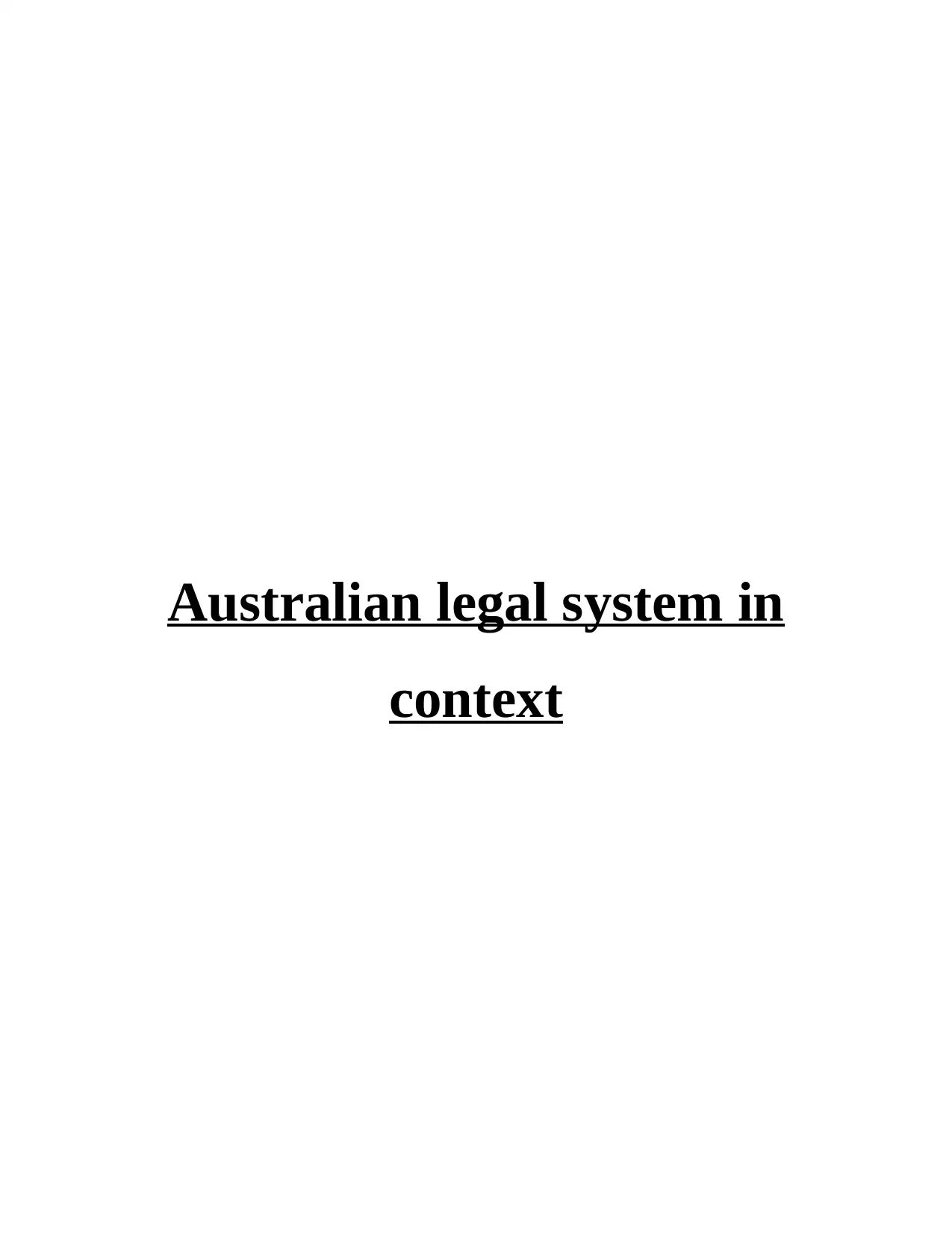
Australian legal system in
context
context
Paraphrase This Document
Need a fresh take? Get an instant paraphrase of this document with our AI Paraphraser

Table of Contents
PART-1............................................................................................................................................3
PART-2............................................................................................................................................4
REFERENCES................................................................................................................................7
PART-1............................................................................................................................................3
PART-2............................................................................................................................................4
REFERENCES................................................................................................................................7
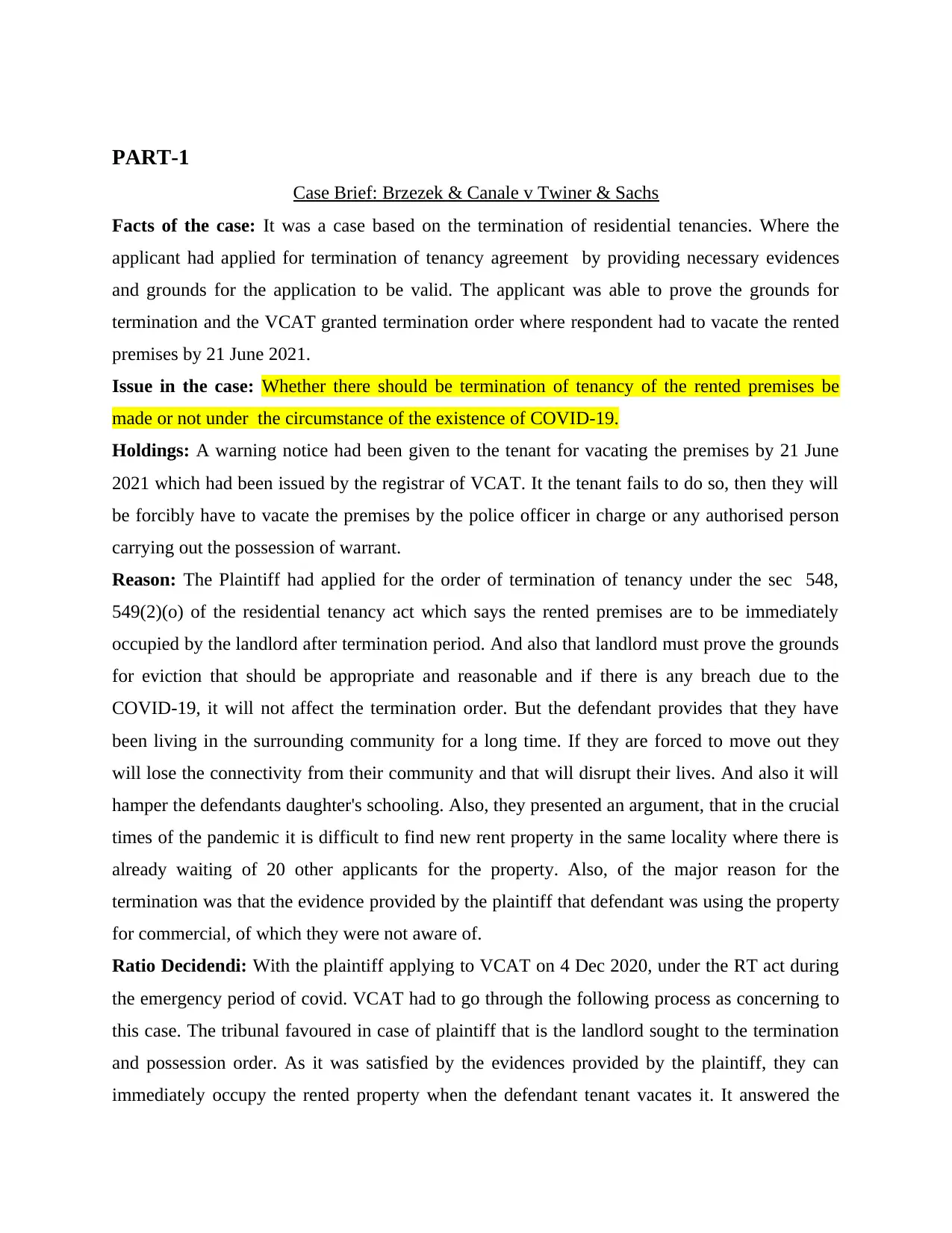
PART-1
Case Brief: Brzezek & Canale v Twiner & Sachs
Facts of the case: It was a case based on the termination of residential tenancies. Where the
applicant had applied for termination of tenancy agreement by providing necessary evidences
and grounds for the application to be valid. The applicant was able to prove the grounds for
termination and the VCAT granted termination order where respondent had to vacate the rented
premises by 21 June 2021.
Issue in the case: Whether there should be termination of tenancy of the rented premises be
made or not under the circumstance of the existence of COVID-19.
Holdings: A warning notice had been given to the tenant for vacating the premises by 21 June
2021 which had been issued by the registrar of VCAT. It the tenant fails to do so, then they will
be forcibly have to vacate the premises by the police officer in charge or any authorised person
carrying out the possession of warrant.
Reason: The Plaintiff had applied for the order of termination of tenancy under the sec 548,
549(2)(o) of the residential tenancy act which says the rented premises are to be immediately
occupied by the landlord after termination period. And also that landlord must prove the grounds
for eviction that should be appropriate and reasonable and if there is any breach due to the
COVID-19, it will not affect the termination order. But the defendant provides that they have
been living in the surrounding community for a long time. If they are forced to move out they
will lose the connectivity from their community and that will disrupt their lives. And also it will
hamper the defendants daughter's schooling. Also, they presented an argument, that in the crucial
times of the pandemic it is difficult to find new rent property in the same locality where there is
already waiting of 20 other applicants for the property. Also, of the major reason for the
termination was that the evidence provided by the plaintiff that defendant was using the property
for commercial, of which they were not aware of.
Ratio Decidendi: With the plaintiff applying to VCAT on 4 Dec 2020, under the RT act during
the emergency period of covid. VCAT had to go through the following process as concerning to
this case. The tribunal favoured in case of plaintiff that is the landlord sought to the termination
and possession order. As it was satisfied by the evidences provided by the plaintiff, they can
immediately occupy the rented property when the defendant tenant vacates it. It answered the
Case Brief: Brzezek & Canale v Twiner & Sachs
Facts of the case: It was a case based on the termination of residential tenancies. Where the
applicant had applied for termination of tenancy agreement by providing necessary evidences
and grounds for the application to be valid. The applicant was able to prove the grounds for
termination and the VCAT granted termination order where respondent had to vacate the rented
premises by 21 June 2021.
Issue in the case: Whether there should be termination of tenancy of the rented premises be
made or not under the circumstance of the existence of COVID-19.
Holdings: A warning notice had been given to the tenant for vacating the premises by 21 June
2021 which had been issued by the registrar of VCAT. It the tenant fails to do so, then they will
be forcibly have to vacate the premises by the police officer in charge or any authorised person
carrying out the possession of warrant.
Reason: The Plaintiff had applied for the order of termination of tenancy under the sec 548,
549(2)(o) of the residential tenancy act which says the rented premises are to be immediately
occupied by the landlord after termination period. And also that landlord must prove the grounds
for eviction that should be appropriate and reasonable and if there is any breach due to the
COVID-19, it will not affect the termination order. But the defendant provides that they have
been living in the surrounding community for a long time. If they are forced to move out they
will lose the connectivity from their community and that will disrupt their lives. And also it will
hamper the defendants daughter's schooling. Also, they presented an argument, that in the crucial
times of the pandemic it is difficult to find new rent property in the same locality where there is
already waiting of 20 other applicants for the property. Also, of the major reason for the
termination was that the evidence provided by the plaintiff that defendant was using the property
for commercial, of which they were not aware of.
Ratio Decidendi: With the plaintiff applying to VCAT on 4 Dec 2020, under the RT act during
the emergency period of covid. VCAT had to go through the following process as concerning to
this case. The tribunal favoured in case of plaintiff that is the landlord sought to the termination
and possession order. As it was satisfied by the evidences provided by the plaintiff, they can
immediately occupy the rented property when the defendant tenant vacates it. It answered the
⊘ This is a preview!⊘
Do you want full access?
Subscribe today to unlock all pages.

Trusted by 1+ million students worldwide
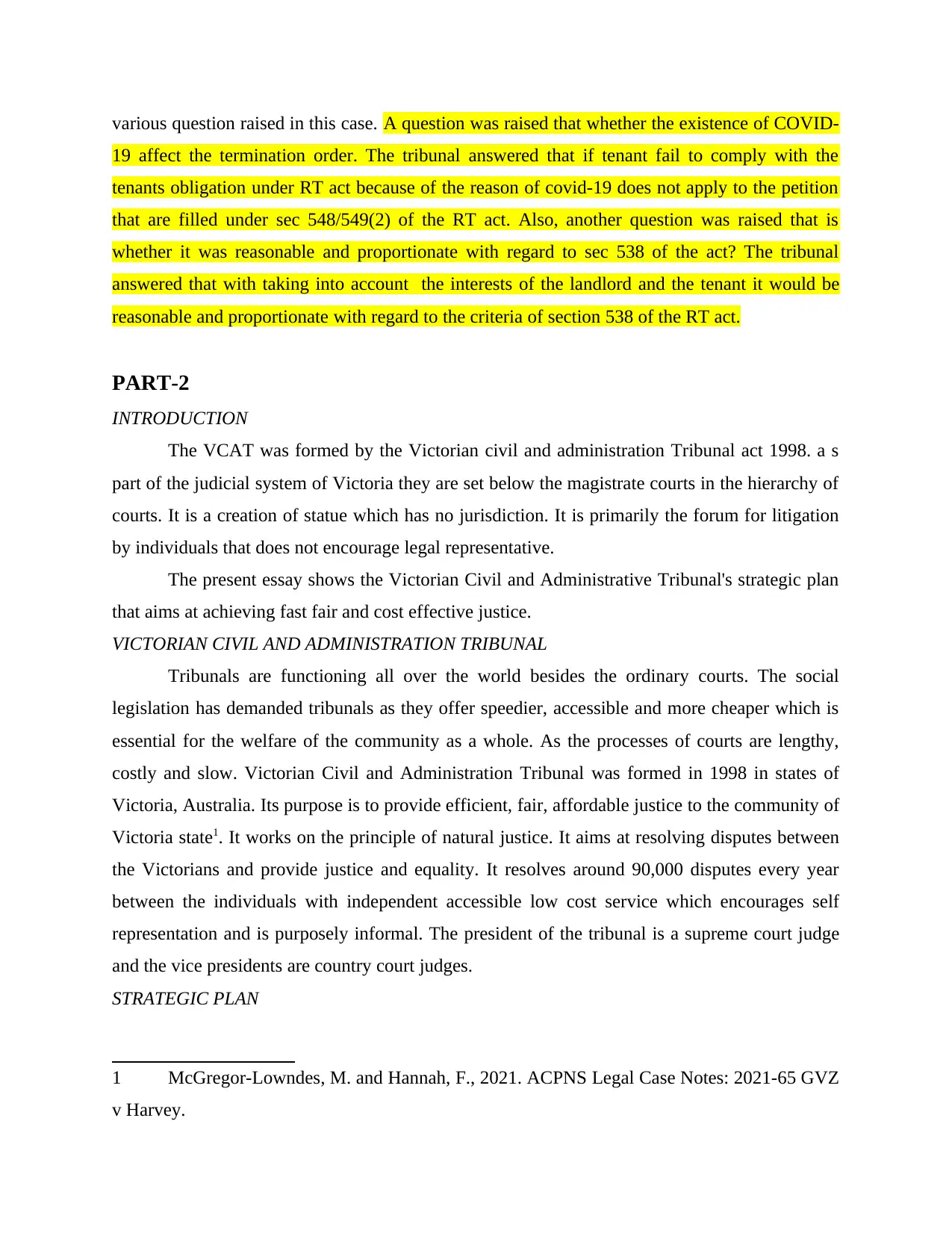
various question raised in this case. A question was raised that whether the existence of COVID-
19 affect the termination order. The tribunal answered that if tenant fail to comply with the
tenants obligation under RT act because of the reason of covid-19 does not apply to the petition
that are filled under sec 548/549(2) of the RT act. Also, another question was raised that is
whether it was reasonable and proportionate with regard to sec 538 of the act? The tribunal
answered that with taking into account the interests of the landlord and the tenant it would be
reasonable and proportionate with regard to the criteria of section 538 of the RT act.
PART-2
INTRODUCTION
The VCAT was formed by the Victorian civil and administration Tribunal act 1998. a s
part of the judicial system of Victoria they are set below the magistrate courts in the hierarchy of
courts. It is a creation of statue which has no jurisdiction. It is primarily the forum for litigation
by individuals that does not encourage legal representative.
The present essay shows the Victorian Civil and Administrative Tribunal's strategic plan
that aims at achieving fast fair and cost effective justice.
VICTORIAN CIVIL AND ADMINISTRATION TRIBUNAL
Tribunals are functioning all over the world besides the ordinary courts. The social
legislation has demanded tribunals as they offer speedier, accessible and more cheaper which is
essential for the welfare of the community as a whole. As the processes of courts are lengthy,
costly and slow. Victorian Civil and Administration Tribunal was formed in 1998 in states of
Victoria, Australia. Its purpose is to provide efficient, fair, affordable justice to the community of
Victoria state1. It works on the principle of natural justice. It aims at resolving disputes between
the Victorians and provide justice and equality. It resolves around 90,000 disputes every year
between the individuals with independent accessible low cost service which encourages self
representation and is purposely informal. The president of the tribunal is a supreme court judge
and the vice presidents are country court judges.
STRATEGIC PLAN
1 McGregor-Lowndes, M. and Hannah, F., 2021. ACPNS Legal Case Notes: 2021-65 GVZ
v Harvey.
19 affect the termination order. The tribunal answered that if tenant fail to comply with the
tenants obligation under RT act because of the reason of covid-19 does not apply to the petition
that are filled under sec 548/549(2) of the RT act. Also, another question was raised that is
whether it was reasonable and proportionate with regard to sec 538 of the act? The tribunal
answered that with taking into account the interests of the landlord and the tenant it would be
reasonable and proportionate with regard to the criteria of section 538 of the RT act.
PART-2
INTRODUCTION
The VCAT was formed by the Victorian civil and administration Tribunal act 1998. a s
part of the judicial system of Victoria they are set below the magistrate courts in the hierarchy of
courts. It is a creation of statue which has no jurisdiction. It is primarily the forum for litigation
by individuals that does not encourage legal representative.
The present essay shows the Victorian Civil and Administrative Tribunal's strategic plan
that aims at achieving fast fair and cost effective justice.
VICTORIAN CIVIL AND ADMINISTRATION TRIBUNAL
Tribunals are functioning all over the world besides the ordinary courts. The social
legislation has demanded tribunals as they offer speedier, accessible and more cheaper which is
essential for the welfare of the community as a whole. As the processes of courts are lengthy,
costly and slow. Victorian Civil and Administration Tribunal was formed in 1998 in states of
Victoria, Australia. Its purpose is to provide efficient, fair, affordable justice to the community of
Victoria state1. It works on the principle of natural justice. It aims at resolving disputes between
the Victorians and provide justice and equality. It resolves around 90,000 disputes every year
between the individuals with independent accessible low cost service which encourages self
representation and is purposely informal. The president of the tribunal is a supreme court judge
and the vice presidents are country court judges.
STRATEGIC PLAN
1 McGregor-Lowndes, M. and Hannah, F., 2021. ACPNS Legal Case Notes: 2021-65 GVZ
v Harvey.
Paraphrase This Document
Need a fresh take? Get an instant paraphrase of this document with our AI Paraphraser
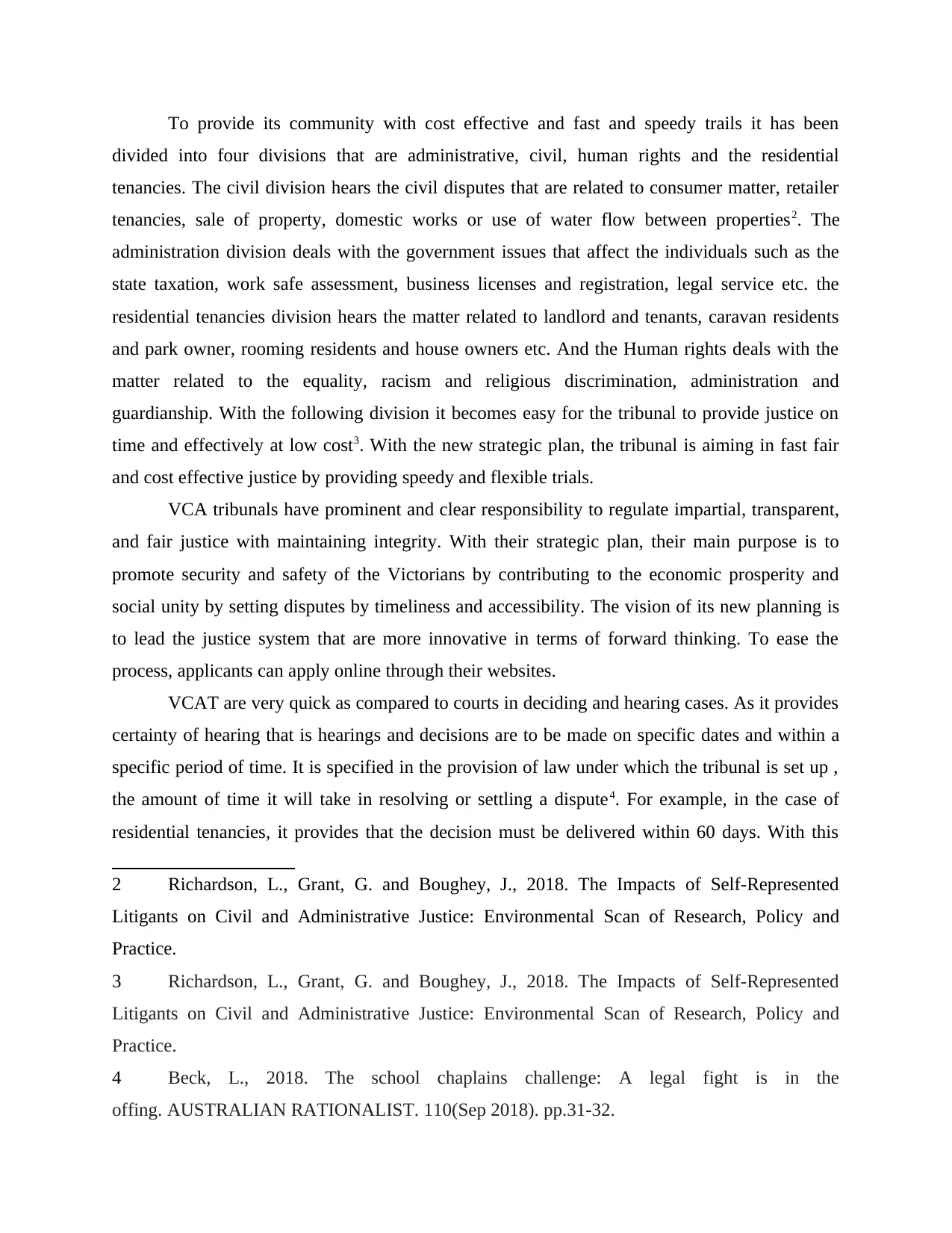
To provide its community with cost effective and fast and speedy trails it has been
divided into four divisions that are administrative, civil, human rights and the residential
tenancies. The civil division hears the civil disputes that are related to consumer matter, retailer
tenancies, sale of property, domestic works or use of water flow between properties2. The
administration division deals with the government issues that affect the individuals such as the
state taxation, work safe assessment, business licenses and registration, legal service etc. the
residential tenancies division hears the matter related to landlord and tenants, caravan residents
and park owner, rooming residents and house owners etc. And the Human rights deals with the
matter related to the equality, racism and religious discrimination, administration and
guardianship. With the following division it becomes easy for the tribunal to provide justice on
time and effectively at low cost3. With the new strategic plan, the tribunal is aiming in fast fair
and cost effective justice by providing speedy and flexible trials.
VCA tribunals have prominent and clear responsibility to regulate impartial, transparent,
and fair justice with maintaining integrity. With their strategic plan, their main purpose is to
promote security and safety of the Victorians by contributing to the economic prosperity and
social unity by setting disputes by timeliness and accessibility. The vision of its new planning is
to lead the justice system that are more innovative in terms of forward thinking. To ease the
process, applicants can apply online through their websites.
VCAT are very quick as compared to courts in deciding and hearing cases. As it provides
certainty of hearing that is hearings and decisions are to be made on specific dates and within a
specific period of time. It is specified in the provision of law under which the tribunal is set up ,
the amount of time it will take in resolving or settling a dispute4. For example, in the case of
residential tenancies, it provides that the decision must be delivered within 60 days. With this
2 Richardson, L., Grant, G. and Boughey, J., 2018. The Impacts of Self-Represented
Litigants on Civil and Administrative Justice: Environmental Scan of Research, Policy and
Practice.
3 Richardson, L., Grant, G. and Boughey, J., 2018. The Impacts of Self-Represented
Litigants on Civil and Administrative Justice: Environmental Scan of Research, Policy and
Practice.
4 Beck, L., 2018. The school chaplains challenge: A legal fight is in the
offing. AUSTRALIAN RATIONALIST. 110(Sep 2018). pp.31-32.
divided into four divisions that are administrative, civil, human rights and the residential
tenancies. The civil division hears the civil disputes that are related to consumer matter, retailer
tenancies, sale of property, domestic works or use of water flow between properties2. The
administration division deals with the government issues that affect the individuals such as the
state taxation, work safe assessment, business licenses and registration, legal service etc. the
residential tenancies division hears the matter related to landlord and tenants, caravan residents
and park owner, rooming residents and house owners etc. And the Human rights deals with the
matter related to the equality, racism and religious discrimination, administration and
guardianship. With the following division it becomes easy for the tribunal to provide justice on
time and effectively at low cost3. With the new strategic plan, the tribunal is aiming in fast fair
and cost effective justice by providing speedy and flexible trials.
VCA tribunals have prominent and clear responsibility to regulate impartial, transparent,
and fair justice with maintaining integrity. With their strategic plan, their main purpose is to
promote security and safety of the Victorians by contributing to the economic prosperity and
social unity by setting disputes by timeliness and accessibility. The vision of its new planning is
to lead the justice system that are more innovative in terms of forward thinking. To ease the
process, applicants can apply online through their websites.
VCAT are very quick as compared to courts in deciding and hearing cases. As it provides
certainty of hearing that is hearings and decisions are to be made on specific dates and within a
specific period of time. It is specified in the provision of law under which the tribunal is set up ,
the amount of time it will take in resolving or settling a dispute4. For example, in the case of
residential tenancies, it provides that the decision must be delivered within 60 days. With this
2 Richardson, L., Grant, G. and Boughey, J., 2018. The Impacts of Self-Represented
Litigants on Civil and Administrative Justice: Environmental Scan of Research, Policy and
Practice.
3 Richardson, L., Grant, G. and Boughey, J., 2018. The Impacts of Self-Represented
Litigants on Civil and Administrative Justice: Environmental Scan of Research, Policy and
Practice.
4 Beck, L., 2018. The school chaplains challenge: A legal fight is in the
offing. AUSTRALIAN RATIONALIST. 110(Sep 2018). pp.31-32.
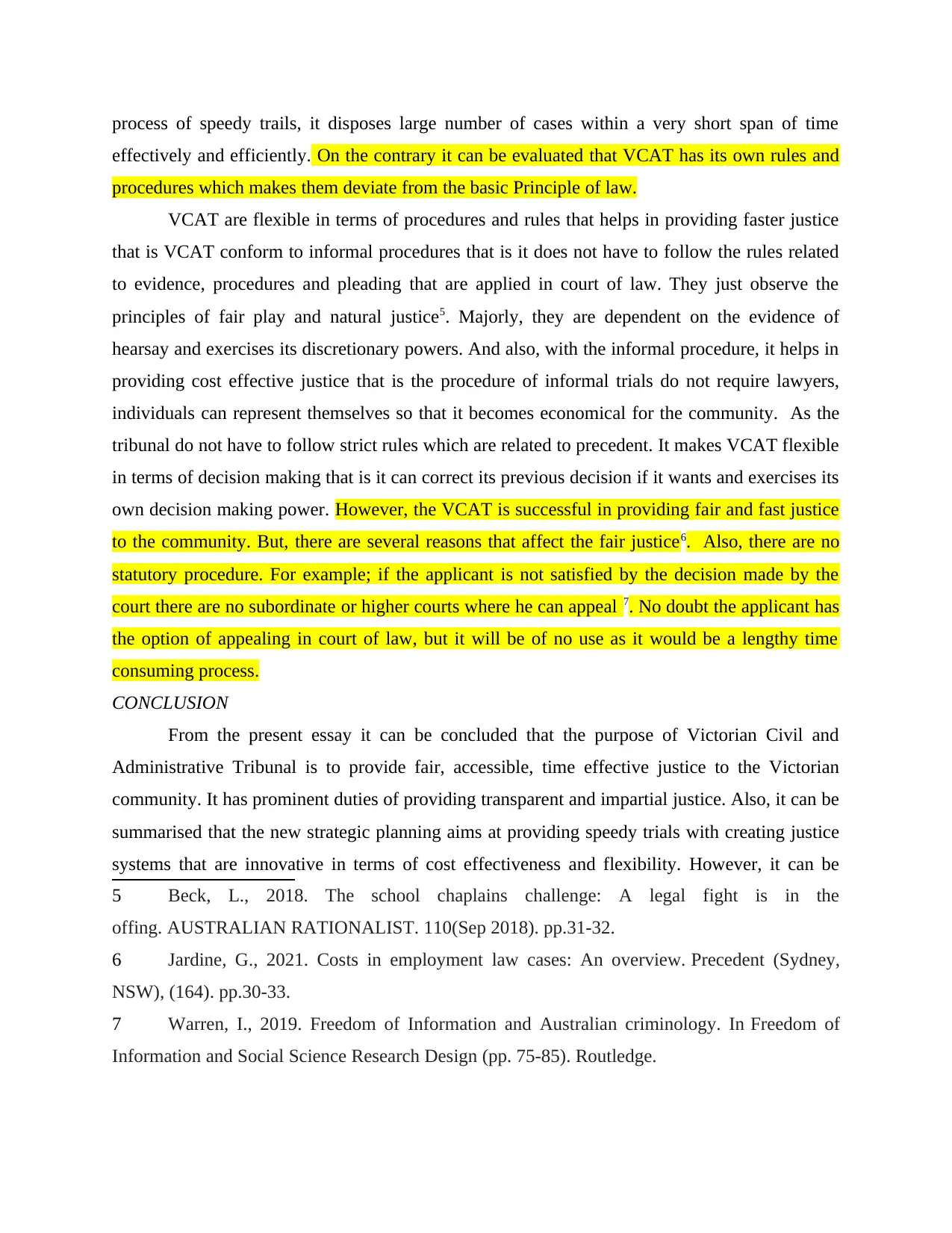
process of speedy trails, it disposes large number of cases within a very short span of time
effectively and efficiently. On the contrary it can be evaluated that VCAT has its own rules and
procedures which makes them deviate from the basic Principle of law.
VCAT are flexible in terms of procedures and rules that helps in providing faster justice
that is VCAT conform to informal procedures that is it does not have to follow the rules related
to evidence, procedures and pleading that are applied in court of law. They just observe the
principles of fair play and natural justice5. Majorly, they are dependent on the evidence of
hearsay and exercises its discretionary powers. And also, with the informal procedure, it helps in
providing cost effective justice that is the procedure of informal trials do not require lawyers,
individuals can represent themselves so that it becomes economical for the community. As the
tribunal do not have to follow strict rules which are related to precedent. It makes VCAT flexible
in terms of decision making that is it can correct its previous decision if it wants and exercises its
own decision making power. However, the VCAT is successful in providing fair and fast justice
to the community. But, there are several reasons that affect the fair justice6. Also, there are no
statutory procedure. For example; if the applicant is not satisfied by the decision made by the
court there are no subordinate or higher courts where he can appeal 7. No doubt the applicant has
the option of appealing in court of law, but it will be of no use as it would be a lengthy time
consuming process.
CONCLUSION
From the present essay it can be concluded that the purpose of Victorian Civil and
Administrative Tribunal is to provide fair, accessible, time effective justice to the Victorian
community. It has prominent duties of providing transparent and impartial justice. Also, it can be
summarised that the new strategic planning aims at providing speedy trials with creating justice
systems that are innovative in terms of cost effectiveness and flexibility. However, it can be
5 Beck, L., 2018. The school chaplains challenge: A legal fight is in the
offing. AUSTRALIAN RATIONALIST. 110(Sep 2018). pp.31-32.
6 Jardine, G., 2021. Costs in employment law cases: An overview. Precedent (Sydney,
NSW), (164). pp.30-33.
7 Warren, I., 2019. Freedom of Information and Australian criminology. In Freedom of
Information and Social Science Research Design (pp. 75-85). Routledge.
effectively and efficiently. On the contrary it can be evaluated that VCAT has its own rules and
procedures which makes them deviate from the basic Principle of law.
VCAT are flexible in terms of procedures and rules that helps in providing faster justice
that is VCAT conform to informal procedures that is it does not have to follow the rules related
to evidence, procedures and pleading that are applied in court of law. They just observe the
principles of fair play and natural justice5. Majorly, they are dependent on the evidence of
hearsay and exercises its discretionary powers. And also, with the informal procedure, it helps in
providing cost effective justice that is the procedure of informal trials do not require lawyers,
individuals can represent themselves so that it becomes economical for the community. As the
tribunal do not have to follow strict rules which are related to precedent. It makes VCAT flexible
in terms of decision making that is it can correct its previous decision if it wants and exercises its
own decision making power. However, the VCAT is successful in providing fair and fast justice
to the community. But, there are several reasons that affect the fair justice6. Also, there are no
statutory procedure. For example; if the applicant is not satisfied by the decision made by the
court there are no subordinate or higher courts where he can appeal 7. No doubt the applicant has
the option of appealing in court of law, but it will be of no use as it would be a lengthy time
consuming process.
CONCLUSION
From the present essay it can be concluded that the purpose of Victorian Civil and
Administrative Tribunal is to provide fair, accessible, time effective justice to the Victorian
community. It has prominent duties of providing transparent and impartial justice. Also, it can be
summarised that the new strategic planning aims at providing speedy trials with creating justice
systems that are innovative in terms of cost effectiveness and flexibility. However, it can be
5 Beck, L., 2018. The school chaplains challenge: A legal fight is in the
offing. AUSTRALIAN RATIONALIST. 110(Sep 2018). pp.31-32.
6 Jardine, G., 2021. Costs in employment law cases: An overview. Precedent (Sydney,
NSW), (164). pp.30-33.
7 Warren, I., 2019. Freedom of Information and Australian criminology. In Freedom of
Information and Social Science Research Design (pp. 75-85). Routledge.
⊘ This is a preview!⊘
Do you want full access?
Subscribe today to unlock all pages.

Trusted by 1+ million students worldwide
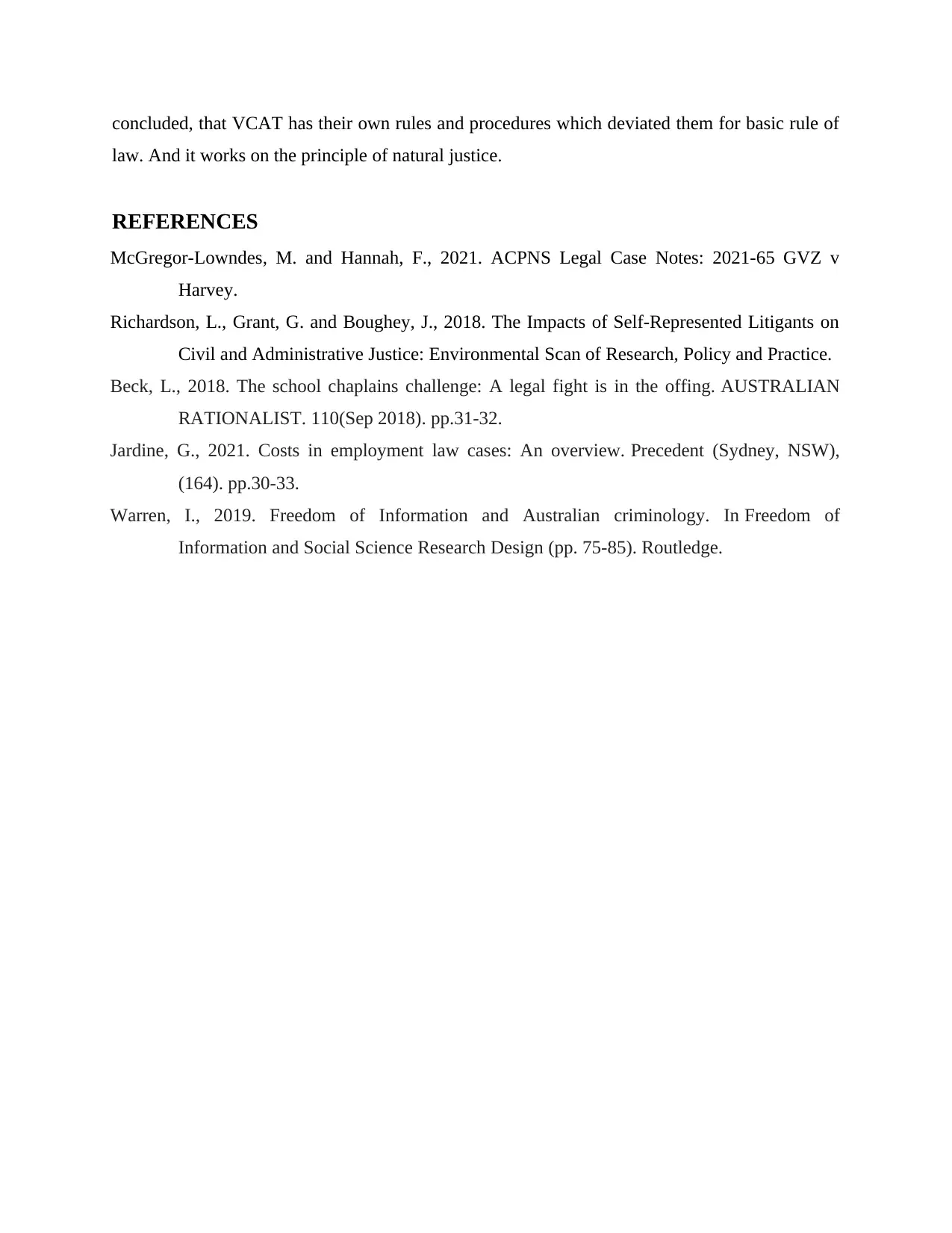
concluded, that VCAT has their own rules and procedures which deviated them for basic rule of
law. And it works on the principle of natural justice.
REFERENCES
McGregor-Lowndes, M. and Hannah, F., 2021. ACPNS Legal Case Notes: 2021-65 GVZ v
Harvey.
Richardson, L., Grant, G. and Boughey, J., 2018. The Impacts of Self-Represented Litigants on
Civil and Administrative Justice: Environmental Scan of Research, Policy and Practice.
Beck, L., 2018. The school chaplains challenge: A legal fight is in the offing. AUSTRALIAN
RATIONALIST. 110(Sep 2018). pp.31-32.
Jardine, G., 2021. Costs in employment law cases: An overview. Precedent (Sydney, NSW),
(164). pp.30-33.
Warren, I., 2019. Freedom of Information and Australian criminology. In Freedom of
Information and Social Science Research Design (pp. 75-85). Routledge.
law. And it works on the principle of natural justice.
REFERENCES
McGregor-Lowndes, M. and Hannah, F., 2021. ACPNS Legal Case Notes: 2021-65 GVZ v
Harvey.
Richardson, L., Grant, G. and Boughey, J., 2018. The Impacts of Self-Represented Litigants on
Civil and Administrative Justice: Environmental Scan of Research, Policy and Practice.
Beck, L., 2018. The school chaplains challenge: A legal fight is in the offing. AUSTRALIAN
RATIONALIST. 110(Sep 2018). pp.31-32.
Jardine, G., 2021. Costs in employment law cases: An overview. Precedent (Sydney, NSW),
(164). pp.30-33.
Warren, I., 2019. Freedom of Information and Australian criminology. In Freedom of
Information and Social Science Research Design (pp. 75-85). Routledge.
1 out of 7
Related Documents
Your All-in-One AI-Powered Toolkit for Academic Success.
+13062052269
info@desklib.com
Available 24*7 on WhatsApp / Email
![[object Object]](/_next/static/media/star-bottom.7253800d.svg)
Unlock your academic potential
Copyright © 2020–2025 A2Z Services. All Rights Reserved. Developed and managed by ZUCOL.




